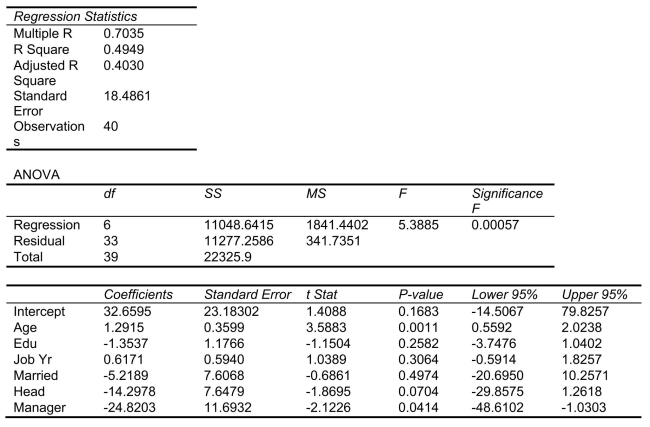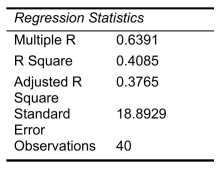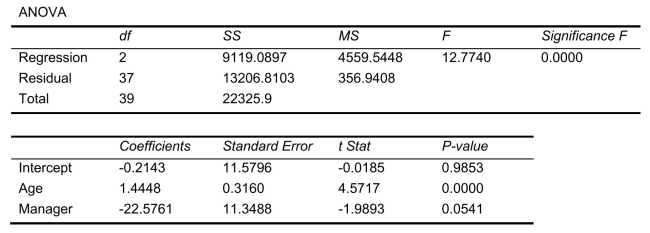SCENARIO 18-10 Given below are results from the regression analysis where the dependent variable is the number of weeks a worker is unemployed due to a layoff (Unemploy)and the independent variables are the age of the worker (Age), the number of years of education received (Edu), the number of years at the previous job (Job Yr), a dummy variable for marital status (Married: 1 = married, 0 = otherwise), a dummy variable for head of household (Head: 1 = yes, 0 = no)and a dummy variable for management position (Manager: 1 = yes, 0 = no).We shall call this Model 1.The coefficient of partial determination  of each of the 6 predictors are, respectively, 0.2807, 0.0386, 0.0317, 0.0141, 0.0958, and 0.1201.
of each of the 6 predictors are, respectively, 0.2807, 0.0386, 0.0317, 0.0141, 0.0958, and 0.1201.  Model 2 is the regression analysis where the dependent variable is Unemploy and the independent variables are Age and Manager.The results of the regression analysis are given below:
Model 2 is the regression analysis where the dependent variable is Unemploy and the independent variables are Age and Manager.The results of the regression analysis are given below: 

-Referring to Scenario 18-10 Model 1, we can conclude that, holding constant the effect of the other independent variables, there is a difference in the mean number of weeks a worker is unemployed due to a layoff between a worker who is married and one who is not at a 5% level of significance if we use only the information of the 95% confidence interval estimate for  .
.
Definitions:
Income from Operations
Revenue generated from a company's core business operations, excluding deductions of expenses and taxes.
Net Income
The sum a company retains as earnings after all taxes and expenses have been deducted from its income.
Periodic Inventory System
A method of inventory valuation in which inventory levels and cost of goods sold are determined at the end of an accounting period.
Cost of Goods Sold
The direct costs attributable to the production of the goods sold by a company, including materials, labor, and manufacturing overhead.
Q11: For a potential investment of $5,000, a
Q33: Referring to Scenario 17-3, what is the
Q43: In multidimensional scaling, the stress statistic is
Q53: Referring to Scenario 20-5, what is the
Q63: Referring to Scenario 19-1, what is the
Q88: Which of the following situations suggests a
Q113: Referring to Scenario 18-12, there is not
Q130: Data on the amount of money made
Q132: Referring to Scenario 19-4, suppose the supervisor
Q170: Referring to Scenario 18-10 Model 1, what